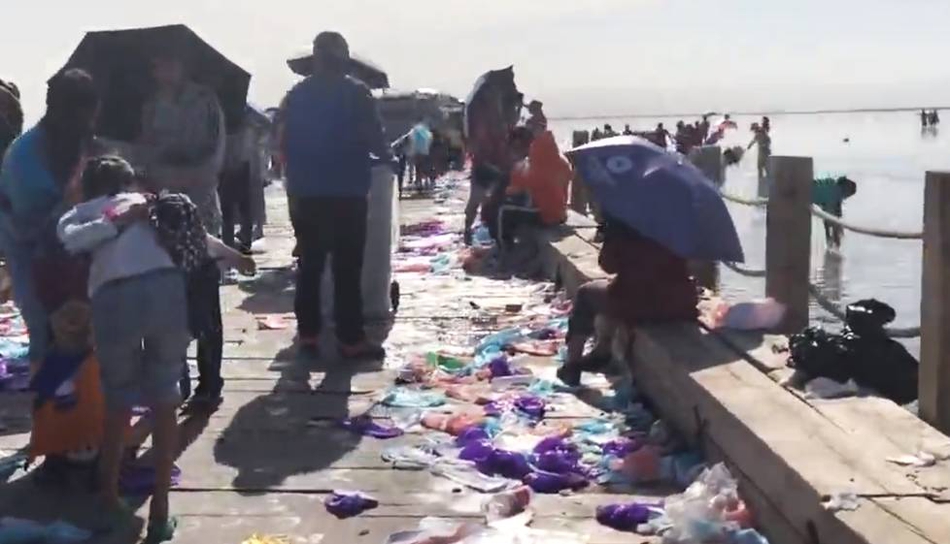【】
From late 1861 through early 1862, a megaflood of historic proportions put large parts of the state of California underwater. The state's Central Valley, which is now one of the most productive agricultural ares in the country, became a vast inland lake. The city of Sacramento, which sits at the intersection of the American and Sacramento rivers, flooded, and remained under water for months.
According to one account, one-quarter of the state's 800,000 cattle drowned in the flooding, and one-third of the state's property was destroyed.
SEE ALSO:Parade of storms threatens to prolong California dam crisisThe "Great Flood" of 1861 to 1862 is becoming more likely to reoccur as the climate warms, a new study finds. A study published Monday in Nature Climate Changefound that despite an overall small change in the state's average yearly precipitation throughout the 20th century and in projections for the future, there may be huge and highly consequential changes in precipitation extremes within seasons, some of which have already begun to buffet the state.
"In practical terms, this means that what is today considered to be the '200-year flood'—an event that would overwhelm the vast majority of California’s flood defenses and water infrastructure—will become the '40-50 year flood' in the coming decades," lead author Daniel Swain, a climate researcher at the University of California at Los Angeles wrote in a blog post on Monday.
 Relative change (in percent) in extremely wet seasons (top), extremely dry seasons (middle), and year-to-year “whiplash” (bottom) by 2070-2100 in Southern California.Credit: Swain et al. 2018.
Relative change (in percent) in extremely wet seasons (top), extremely dry seasons (middle), and year-to-year “whiplash” (bottom) by 2070-2100 in Southern California.Credit: Swain et al. 2018.In an interview, Swain said he was surprised how sharply the risk of another "Great Flood" event increased just over the next 40 years, according to the numerous computer model simulations used in the study.
The study found that between 2018 and 2060, California's major urban areas, including San Francisco and Los Angeles, "are more likely than not" to experience at least one extremely severe storm sequence that is similar in magnitude to the Great Flood. This is a three-fold increase in the risk of such a devastating event.
Swain said this result “is pretty eyebrow-raising, certainly to me, it and may raise some eyebrows in the emergency planning community as well.”
That flood was the result of an unrelenting series of storms that channeled a firehose of moisture off the Pacific Ocean, known as "atmospheric river" weather systems.
The study makes for sobering reading, because it shows how sharply the risk of both extremely wet and dry seasons is increasing, along with what the authors term "precipitation whiplash" as the climate oscillates between these two extremes.
Previous studies, Swain said, had focused on how annual average precipitation may change as the climate warms, but the relatively small amount of change at this timescale is effectively masking far more consequential trends at shorter timescales. “That seems to be masking very significant changes in the character of precipitation” and precipitation extremes, Swain said.
The researchers utilized computer models to simulate precipitation trends in California during the remainder of the 21st century, studying results from simulations including the "business as usual" course of greenhouse gas emissions as well as control runs that did not include an increase in global warming pollutants.
 Increasing frequency of precipitation extremes in California.Credit: Ucla/daniel swain.
Increasing frequency of precipitation extremes in California.Credit: Ucla/daniel swain.One of the more unique insights the study provides is the likelihood that there will be more frequent and drastic year-to-year precipitation shifts, much like the one that occurred between a record drought that lasted from about 2012 to 2016, and was followed by a record wet winter in parts of California during the winter of 2016 to 2017. The wet winter peaked with the failure of a spillway at the Oroville Dam in 2017, which forced about 250,000 people to evacuate.
The study projects a 25 to 100 percent increase in such precipitation whiplash events during the coming years.
As the study notes, California's water infrastructure is simply not prepared for such an escalation in extreme events. The study states:
Few of the dams, levees and canals that currently protect millions living in California’s flood plains and facilitate the movement of water from Sierra Nevada watersheds to coastal cities have been tested by a deluge as severe as the extraordinary 1861–1862 storm sequence —a repeat of which would probably lead to considerable loss of life and economic damages approaching a trillion dollars.
The study is consistent with other findings on how precipitation extremes are already changing as the climate warms, but it may actually underestimate the severity of these changes for California, said Kevin Trenberth, a senior researcher at the National Center for Atmospheric Research (NCAR) in Boulder, Colorado. Trenberth was not involved in the new study.
In general, a warmer world will provide storms with more moisture to work with, as the air's capacity to hold water vapor and the evaporation rates from the land and sea all increase. There's already observational evidence showing this is taking place.
But this new study serves as a warning that coming decades will bring a wild ride from one extreme to the next, challenging even our sturdiest, most modern infrastructure.
Buckle up.
Featured Video For You
- 头条新闻
- 'The Flying Bum' aircraft crashes during second test flight
- How Jadeveon Clowney went from draft bust to forceful freak of nature
- HTC's new flagship has two displays, but no headphone jack
- 2016's 'Hitman' was great because it didn't let players binge
- Snapchat is about to explode in popularity, report says
- YouTube is removing North Korean content and no one knows why
- Fans uncover the backstory for the next 'Legend of Zelda'
- This book service wants to help you celebrate black excellence in literature
- Researchers create temporary tattoos you can use to control your devices
- Here's some of the major newspaper front pages from Inauguration Day
- 图片新闻
- 新闻排行榜








